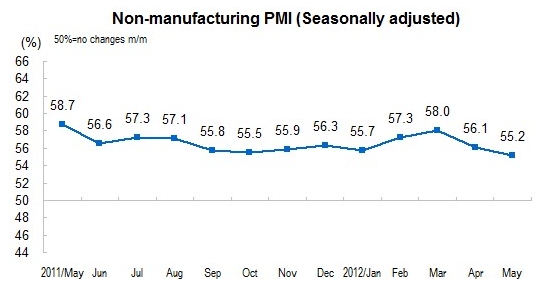China Federation of Logistics and Purchasing (CFLP)
In May, non-manufacturing purchasing manager index was 55.2 percent, 0.9 percentage points lower than that in the previous month, still staying above the threshold.
In view of different industries, the purchasing manager index of construction was 59.2 percent, 1.1 percentage points lower than that in the previous month, but still positioned in the high level of the range, which indicated that the business activities of construction industry was more active. The purchasing manager index of service was 54.2 percent, dropped 0.8 percentage points month-on-month, of which, water transport, air transport, retail, leasing and business services positioned in the high place above 59 percent, the total enterprise business of catering, accommodation, real estate, internet and software, IT services industry decreased month-on-month.

The new orders index declined slightly. The new orders index was 52.5 percent, a decrease of 0.2 percentage points compared with the previous month, indicating that the non-manufacturing market demands continued to maintain growth, but the growth has decelerated. In view of different industries, the new orders index of construction industry was 54.2 percent, remained the same level over the previous month, which indicated that the growth rate of market demands of construction industry kept stable. The new orders index of service industry was 52.1 percent, 0.2 percentage points lower than that in the previous month, which indicated that the new orders growth of service industry dropped. Of which, the new orders of accommodation, residential services, repair industry, and real estate industry stayed below the threshold, which indicated lack of market demand.
Intermediate input price index dropped continuously. This index was 53.6 percent, down 4.3 percentage points than that in the previous month, which indicated that the growth rate of intermediate input price index of non-manufacturing enterprises significantly narrowed. In view of different industries, the intermediate input price indices of construction industry was 49.7 percent, significant decreased 6.6 percentage points month-on-month, positioned below the threshold, which indicated that construction production and operating costs went down. The intermediate input price indices of service industry was 54.5 percent, down by 3.7 percentage points month-on-month, the rising operating cost pressures have eased, of which, wholesale industry, and water transport industry were below the threshold.
The subscription price index went below the threshold, reaching 48.5 percent, a month-on-month decrease of 1.8 percentage points, below the threshold, which indicated that sales of non-manufacturing enterprises or charging prices fell month-on-month. In view of different industries, the subscription price index of construction industry was 49.9 percent, went down to near the threshold, enterprise price charged a little month-on-month. The subscription price index of service industry was 48.2 percent, dropped 1.9 percentage points month-on-month, positioned below the threshold, of which, whole sale industry, accommodation, telecommunications, radio, television and satellite transmission services industry, real estate industry were below the threshold, and the enterprise subscription price decreased month-on-month.
Business activities expectation index dropped for 2 consecutive months which stood at 65.4 percent this month, 0.7 percentage points lower month-on-month, still positioned in the high place of the range, which indicated that the non-manufacturing enterprises still continued to be optimistic. In view of different industries, the business activities expectation indices of house construction industry, air and railway transport industry, telecommunications, radio, television and satellite transmission services industry were all staying at a high level of 70 percent and above.
| China's Non-manufacturing PMI (Seasonally adjusted) | |||||
| Unit: % | |||||
| 2012 | Non-manufacturing PMI | New Orders Index | Intermediate Input Price Index | Subscription Price Index | Business Activities Expectation Index |
|
|
|
|
|
|
|
| January | 55.7 | 52.2 | 58.2 | 51.1 | 65.3 |
| February | 57.3 | 52.7 | 59.0 | 51.2 | 63.8 |
| March | 58.0 | 53.5 | 60.2 | 52.0 | 66.6 |
| April | 56.1 | 52.7 | 57.9 | 50.3 | 66.1 |
| May | 55.2 | 52.5 | 53.6 | 48.5 | 65.4 |
|
|
|
|
|
|
|
Annotations:
1. Seasonal Adjustment Note
The purchasing manager's survey is a monthly survey, great fluctuations of data which affected by seasonal factors. At present, time series of China's non-manufacturing PMI have met the technical requirements of the seasonally adjustment, and the sub-indices of non-manufacturing PMI data on seasonally adjusted will be released since March 2012.
2. Explanatory Notes
China non-manufacturing purchasing manager index system constituted by 10 sub-indices, they are business activity index, new orders index, new export orders index in hand orders index, stock index, intermediate input price index, subscription price index, employment index, supplier delivery time index, and business activities expectation index. Due to the lack of synthesis of non-manufacturing integrated PMI index, the international society often used business activity index to reflect the overall changes in non-manufacturing economic development, A PMI reading above 50 percent indicates expansion from the previous month, while below indicates contraction.
3. Statistical Coverage
The survey involves 27 manufacturing industry categories in the "Industrial Classification for National Economic Activities" (GB/T4754-2011), and was conducted in 1200 sampling enterprises of the non-manufacturing sector countrywide.
4. Survey Methods
Non-manufacturing purchasing managers' survey was conducted in PPS (Probability Proportional to Size) sampling method, using the industry categories as the selecting layers, distributing the sample sizes according to the proportion that the added value of the industry accounted for the added value of all the manufacturing sectors, and selecting samples within layers by the probability proportional with the main business revenue of the enterprises.
The survey was conducted by networking directly reporting and carried out by interviewing the enterprises' purchasing managers monthly using questionnaire method.
5. Calculation Methods
Non-manufacturing purchasing managers survey involves 10 questions on production, new orders (business required), export, existing orders, finished goods inventory, intermediate input price, subscription price, employees, suppliers delivery time, and business activities expectation. Diffusion index was calculated on each question, i.e. percentage of positive answers in number of enterprises plus half of the percentage in the same answers.





